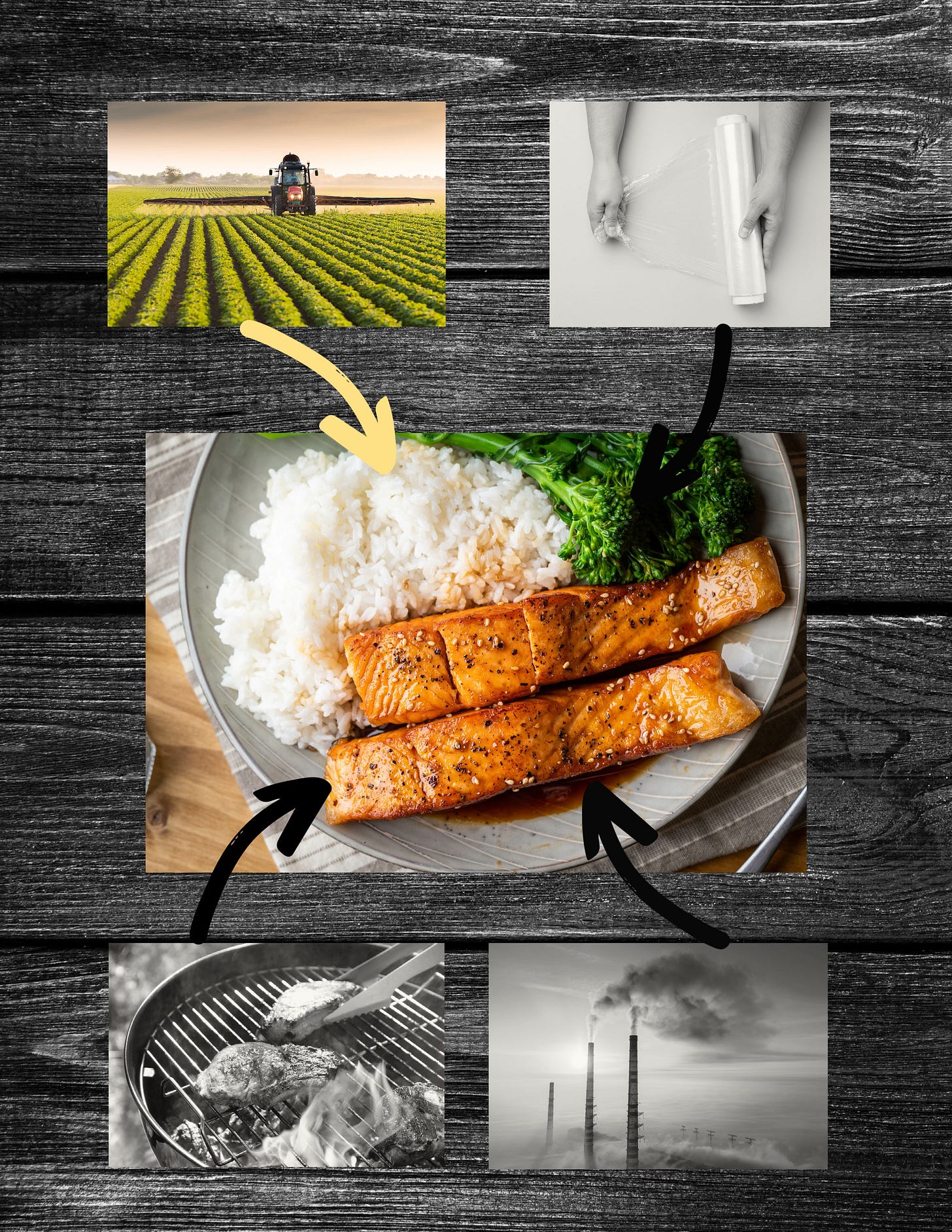“Conventional” farming as a source of toxic chemicals to food
Conventional, a.k.a. chemically-intensive farming can be a source of toxic chemicals to our food. Pesticides, such as insecticides, herbicides, and fungicides, may be directly sprayed, leftover from a prior crop, or drift in from an adjacent field. Growth regulators and sprouting inhibitors may also be applied after harvest.
Why be concerned about pesticides in your food? A review of pesticide exposures and associated human health impacts identified links to cancer, neurological disorders, and endocrine disruption.1 I’ll discuss how you can reduce your exposure below.
Analysis by the USDA2 has detected not just chemicals approved for use in the U.S., but also those no longer registered here, such as dieldrin, endrin, and chlordane, either due to their continued use in other countries or because they persist in soils where crops are grown. Of the produce tested, 46.1% contained residues of more than one pesticide or its metabolites, 26.3% contained one residue, and 27.6% contained none detected. One sample each of grapes and pears contained residues of 18 pesticides. Produce containing pesticide residues that exceeded the EPA’s tolerance levels included green beans (38 samples), grapes (6), peaches (4), and blueberries (2). Two thirds of those were imported.
Note that it’s not just produce you need to be aware of. The Environmental Working Group tested other food items and found that oats, beans and legumes, the herbs cilantro and basil, and rice and wheat were also a source of pesticides and their metabolites to diets.3 And researchers in France found that children who consumed more pasta, rice or semolina, breakfast cereals and whole grain breads had higher levels of pyrethroid metabolites in their urine.4
While most of the produce tested by the USDA contained pesticide levels lower than EPA tolerance levels, those do not consider synergistic and additive effects of multiple pesticides on the body, nor do they test all potential health effects.5 Researchers have noted synergistic effects of multiple pesticides on human liver cells and salmon,6,7 meaning they amplify the toxic effects of each other. They also do not consider the combined effect of other toxic chemicals you may be exposed to.
Choosing organic produce can help reduce your body burdens and health effects of these chemicals. In several studies, children and adults had lower levels of pesticides and their metabolites in urine when switched from conventional to organic diets.8-10 And in a study of 68,946 French adults, researchers noted a significant reduction (~25%) in cancer risk among consumers eating more organic food.11 In another study, those consuming the highest proportion of organic foods had the fewest cases of non-Hodgkin’s lymphoma.12
Does washing or peeling produce help remove pesticides? Either of those actions may remove some surficial pesticides but will not clear residues that have penetrated through the peel and into the pulp,13 nor will it remove the pesticides that have translocated into edible portions of the plant from pesticide-contaminated soils. For more information, check out my recent blog on foraging.
Bottom line - don’t skip eating produce, which is an important part of a healthy diet. For less expensive organic produce and other foods, the Mayo Clinic recommends buying in-season from local organic farmers, joining a CSA, and buying bulk grains and beans. Here are a couple of resources to help you decide which fruits and vegetables to buy organic and which “conventional” versions are less contaminated:
Request Environmental Working Group’s downloadable version of their dirty dozen and clean fifteen produce lists: https://www.ewg.org/foodnews/dirty-dozen.php
Consumer Reports also has a guide you can check: https://www.consumerreports.org/health/food-contaminants/produce-without-pesticides-a5260230325/
Note – You may also be exposed to pesticides through direct use in your home or garden and roadside spraying by municipalities. Minimizing use of these chemicals would be wise.
References
1. Shekhar, C. et al. 2024. A systematic review of pesticide exposure, associated risks, and long-term human health impacts Toxicol. Rep. 13:101840.
2. U.S. Department of Agriculture. Pesticide Data Program Annual Summary, Calendar Year 2022. https://www.ams.usda.gov/sites/default/files/media/2022PDPSummary.pdf
3. Environmental Working Group. 2024. These four foods are high in pesticides – try organic to reduce your exposure. https://www.ewg.org/foodnews/five-lesser-known-foods-high-in-pesticides.php
4. Glorennec, P. et al. 2017. Determinants of children’s exposure to pyrethroid insecticides in western France. Environ. Int. 14:76-82.
5. Gillam, C. 2018. Chemicals on our food: When ‘safe’ may not really be safe. Organic Consumers Association.
6. Wang, R. et al. 2023. Synergistic effects on oxidative stress, apoptosis and necrosis resulting from combined toxicity of three commonly used pesticides on HepG2 cells. Ecotox. and Environ. Safety. 263:115237.
7. Laetz, C. A. et al. 2008. The synergistic toxicity of pesticide mixtures: Implications for risk assessment and the conservation of endangered Pacific Salmon. Environ. Health Perspect. 117:348-53.
8. Lu, Ch. et al. 2005. Organic diets significantly lower children’s dietary exposure to organophosphorus pesticides. Environ. Health Perspect. 114:260-3.
9. Bradman, A. et al. 2015. Effect of organic diet intervention on pesticide exposures in young children living in low-income urban and agricultural communities. Environ. Health Perspect. 123:1086-93.
10. Hyland, C. et al. 2019. Organic diet intervention significantly reduces urinary pesticide levels in U.S. children and adults. Environ. Research, 171:568-575.
11. Baudry, J. et al. (2018). Association of frequency of organic food consumption with cancer risk. JAMA Intern. Med. 178:1597-1606.
12. Mayo Clinic. Organic foods: Are they safer? More nutritious? https://www.mayoclinic.org/healthy-lifestyle/nutrition-and-healthy-eating/in-depth/organic-food/art-20043880
13. Lin, Z. et al. 2024. Cellulose surface nanoengineering for visualizing food safety. Nano Lett. 24:10016-23.




